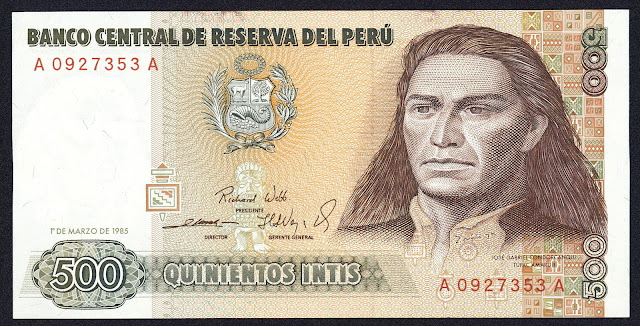Peru Banknotes 500 Intis banknote 1985 Tupac Amaru II
Central Reserve Bank of Peru - Banco Central de Reserva del Perú
Obverse: Portrait of Jose Gabriel Condorcanqui Tupac Amaru II (1738-1781) was the leader of an indigenous uprising in 1780 against the Spaniards in colonial Peru. Although unsuccessful, he later became a mythical figure in the Peruvian struggle for independence and indigenous rights movement and an inspiration to a myriad of causes in Peru, as diverse as the Revolutionary Government of the Armed Forces (1968-1980), the Shining Path (also known as the Communist Party of Peru) and the MRTA.
Reverse: Huascaran Mountain and alpinist.
Watermark: Portrait of Tupac Amaru II.
Original Size: 150 x 75 mm
Peru Banknotes - Peruvian Paper Money
1985-1991 "Inti" Issue
The inti was introduced on 1 February 1985, replacing the sol which had suffered from high inflation. One inti was equivalent to 1,000 soles. Coins denominated in the new unit were put into circulation from May 1985 and banknotes followed in June of that year.Tupac Amaru II
José Gabriel Túpac Amaru (March 19, 1742 – May 18, 1781) — known as Túpac Amaru II — was the leader of an indigenous uprising in 1780 against the Spanish in Peru. Although unsuccessful, he later became a mythical figure in the Peruvian struggle for independence and indigenous rights movement, as well as an inspiration to myriad causes in Hispanophone America and beyond.
Túpac Amaru II was born José Gabriel Condorcanqui in Surimana, Tungasuca, in the province of Cuzco, and received a Jesuit education at the San Francisco de Borja School, although he maintained a strong identification with the indigenous culture and population. He was a mestizo who claimed to be a direct descendant of the last Inca ruler Túpac Amaru. He had been given the title of Marquis of Oropesa, a position that allowed him some voice and political leverage during Spanish rule. Between 1741 and 1780 Amaru II went into litigation with the Betancur family over the right of succession of the Marquisate of Oropesa and lost the case. In 1760, he married Micaela Bastidas Puyucahua of Afro-Peruvian and indigenous descent. Tupac Amaru II inherited the caciqueship, or hereditary chiefdom of Tungasuca and Pampamarca from his older brother, governing on behalf of the Spanish governor.
He was quartered and beheaded by the colonial authorities in Cuzco in 1781.
Huascaran Mountain
Huascarán or Nevado Huascarán is a mountain in the Peruvian province of Yungay (Ancash Departament), situated in the Cordillera Blanca range of the western Andes. The highest southern summit of Huascarán (Huascarán Sur) is the highest point in Peru, northern part of Andes (north of Lake Titicaca) and in all of the Earth's Tropics. Huascarán is the fourth highest mountain in the Western Hemisphere after Aconcagua, Ojos del Salado, and Monte Pissis. The mountain was named after Huáscar, a 16th-century Inca emperor who was the Sapa Inca of the Inca empire.
The mountain has two distinct summits, the higher being the south one (Huascarán Sur) with an elevation of 6,768 metres (22,205 ft). The north summit (Huascarán Norte) has an elevation of 6,654 metres (21,831 ft). Both summits are separated by a saddle (called 'Garganta'). The core of Huascarán, like much of the Cordillera Blanca, consists of Cenozoic era granite.
Huascarán gives its name to Huascarán National Park which surrounds it, and is a popular location for trekking and mountaineering. The Huascarán summit is one of the points on the Earth's surface farthest from the Earth's center, closely behind the farthest point, Chimborazo in Ecuador.
The summit of Huascarán is the place on Earth with the smallest gravitational force.
Huascarán is normally climbed from the village of Musho to the west via a high camp in the col that separates the two summits, known as La Garganta. The ascent normally takes five to seven days, the main difficulties being the large crevasses that often block the route. The normal route is of moderate difficulty and rated between PD and AD (depending on the conditions of the mountain) according to the International French Adjectival System.
The summit of Huascarán Sur was first reached on 20 July 1932 by a joint German–Austrian expedition. The team followed what would become later the normal route (named today Garganta route). The north peak (Huascarán Norte) had previously been climbed on 2 September 1908 by a U.S. expedition that included Annie Smith Peck, albeit this first ascent is somewhat disputed.
In 1989, a group of eight amateur mountaineers, the "Social Climbers", held what was recognised by the Guinness Book of Records (1990 edition) to be "the world's highest dinner party" on top of the mountain, as documented by Chris Darwin and John Amy in their book The Social Climbers, and raised £10,000 for charity.
The Huascarán massif spans from relatively easy to very challenging. The relative low technical difficulty of the normal route attracts many inexperienced climbers, so that a number of fatalities have occurred on the mountain.

